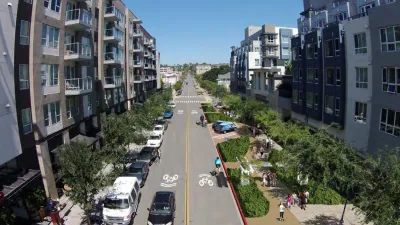The unlikely alliance of a ballpark billionaire, tax watchdog, and environmentalists in San Diego circulate a planning ballot initiative that makes an all-too-familiar sacrifice: urban neighborhoods.
A struggle is taking shape in San Diego. It's a struggle oft repeated in the last century of urban development in this country, writes land use attorney and UrbDeZine editor Bill Adams in this opinion piece. It pits the goals of a city-at-large against the aspirations and gains of urban neighborhoods. It's also a struggle of money, race, and ethnicity.
A year and a half ago, the city overrode the Community Plan adopted by Barrio Logan, a predominantly Hispanic urban neighborhood adjacent to downtown, with the highest air pollution and asthma rates in the county. It did so via ballot initiative funded by maritime industries bordering the community resulting in a city-wide election that invalidated the Community Plan buffer between industry expansion and Barrio Logan residents.
Once again, a well-funded planning ballot initiative has been gathering signatures. It would directly impact not only Barrio Logan but also East Village and several adjacent neighborhoods. Again, the ballot initiative excluded input from the impacted neighborhoods—failed even to acknowledge their existence. This ballot initiative is funded by former Padres pro-baseball team owner and downtown developer John Moores / JMI Realty. It is also funded and supported by tax, transparency, and environmental watchdog attorney Cory Briggs. Donna Frye, a former city council member, mayoral candidate, and environmentalist, is also a staunch supporter of the initiative.
The initiative, if passed, accomplishes several goals for its proponents: It brings a convention center expansion, and possibly an NFL stadium, closer to JMI landholdings and hotels. It facilitates the transfer of the old home of the NFL Chargers—Qualcomm Stadium—to San Diego State University. It sets aside park space along the San Diego River at the Qualcomm stadium site. It creates additional funding for coastal access, recreation, and river restoration. It eliminates direct taxpayer stadium funding—it's most admirable ingredient—although it's effect on indirect funding, e.g., as by donation of city property, is murky. It stops expansion of the Convention Center on the waterfront - a coastal access issue (although the impact on coastal access appears minimal). It replaces the expansion with a sub-optimal (from a convention viewpoint) non-contiguous annex. It would also increase the transient occupancy tax on hotel guests—a previously contested issue.
The selling point to the public? It offers the hope of a downtown NFL stadium—the Chargers' preferred stadium location before seeking to move to L.A.—in the city's attempt to retain them or replace them with another NFL team. (The Chargers have been given another year by NFL owners to work out a deal with either the city of San Diego or with Rams owner Stan Kroenke on a shared L.A. stadium.)
However, the initiative repeats a traditional bias. It's the same bias that resulted in the routing of highways through working class urban neighborhoods while avoiding more well-to-do neighborhoods, and the destruction of urban neighborhoods in "urban renewal" programs benefiting developers more than residents of the impacted urban enclaves. The initiative backers failed to ask the impacted neighborhoods if they wanted a convention center, stadium, parking structures and lots, and ancillary lodging and "entertainment" development in or adjacent to their neighborhoods. The initiative would infuse more low wage service sector employment near these neighborhoods. The initiative threatens the fledgling renaissance of innovation district type businesses—providing upward mobility jobs—that have recently moved into the urban core. The initiative would continue the pattern of keeping higher wage employment at the outskirts of the public transit network (think multiple transfers). Finally, by utilizing Public Resources code 21178, signed into law in 2011 by Governor Brown, the Plan would deprive residents of input or recourse, even regarding health impacts (especially sensitive issue in Barrio Logan) from such things as increased traffic to the proposed convention or stadium facilities.
In sum, the initiative would override neighborhood plans, goals, and internally-initiated revitalization in a city-wide election in which suburbanites and NFL fans vastly outnumber urban voters.
FULL STORY: A beach, burb, and billionaire "Citizens' Plan" for San Diego's urban neighborhoods

Alabama: Trump Terminates Settlements for Black Communities Harmed By Raw Sewage
Trump deemed the landmark civil rights agreement “illegal DEI and environmental justice policy.”

Planetizen Federal Action Tracker
A weekly monitor of how Trump’s orders and actions are impacting planners and planning in America.

The 120 Year Old Tiny Home Villages That Sheltered San Francisco’s Earthquake Refugees
More than a century ago, San Francisco mobilized to house thousands of residents displaced by the 1906 earthquake. Could their strategy offer a model for the present?

Ken Jennings Launches Transit Web Series
The Jeopardy champ wants you to ride public transit.

BLM To Rescind Public Lands Rule
The change will downgrade conservation, once again putting federal land at risk for mining and other extractive uses.

Indy Neighborhood Group Builds Temporary Multi-Use Path
Community members, aided in part by funding from the city, repurposed a vehicle lane to create a protected bike and pedestrian path for the summer season.
Urban Design for Planners 1: Software Tools
This six-course series explores essential urban design concepts using open source software and equips planners with the tools they need to participate fully in the urban design process.
Planning for Universal Design
Learn the tools for implementing Universal Design in planning regulations.
Clanton & Associates, Inc.
Jessamine County Fiscal Court
Institute for Housing and Urban Development Studies (IHS)
City of Grandview
Harvard GSD Executive Education
Toledo-Lucas County Plan Commissions
Salt Lake City
NYU Wagner Graduate School of Public Service




























